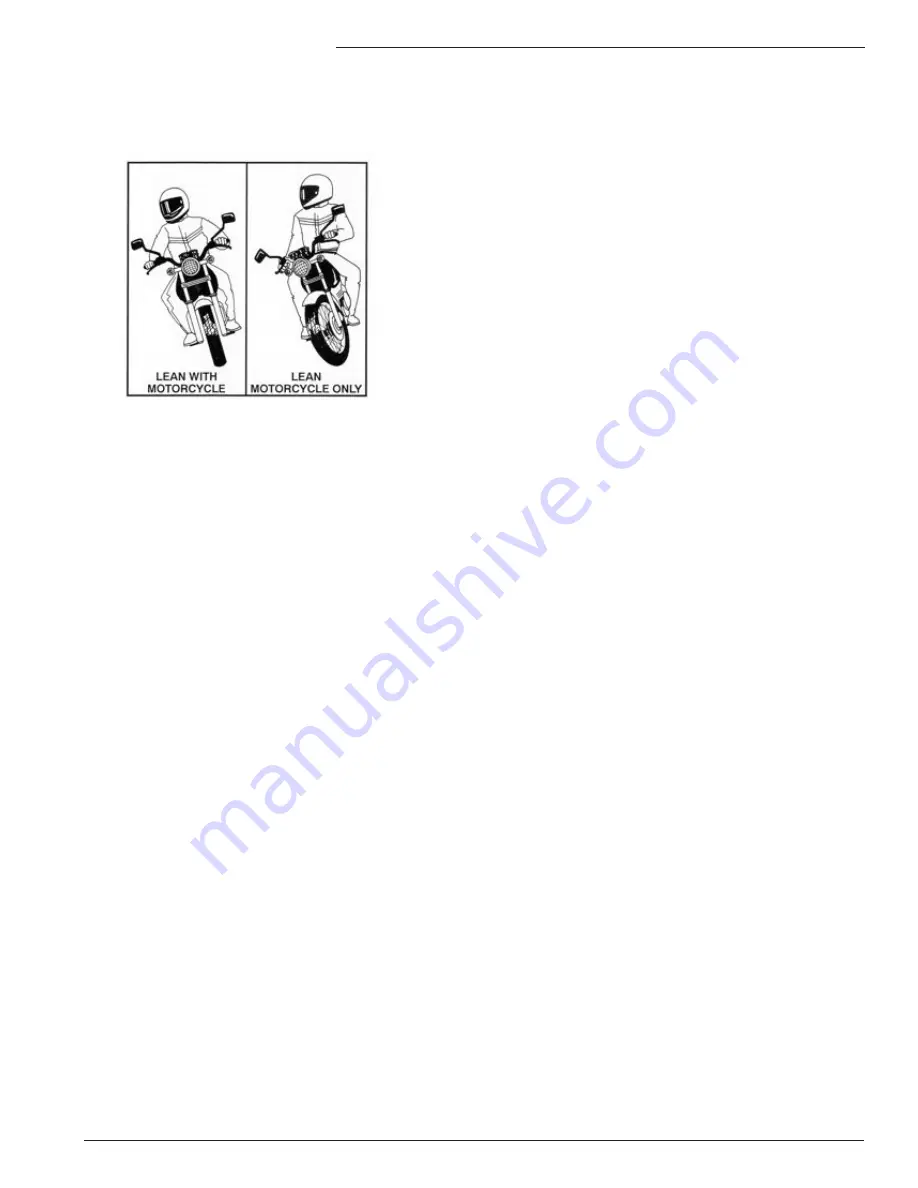
6
Colorado Motorcycle Operator’s Handbook
In normal turns, the rider and motorcycle should lean
together. In slow tight turns, lean the motorcycle only and
keep your body straight. Higher speeds and/or tighter
turns require more lean.
Unique to a 3-wheel motorcycle is the need to
adjust your upper body position during cornering.
It is necessary to lean in the direction you intend to
turn to avoid raising the inside wheel and, possibly,
ÁLSSLQJRYHU/HDQLQJOLNHWKLVLVVRPHWLPHVUHIHUUHGWRDV
“hanging off.” This will be very important with a sidecar-
equipped motorcycle if the sidecar has no weight in it.
ROLL: Roll on the throttle through the turn. Maintain steady
speed or gradually accelerate. Avoid deceleration while in
the turn.
Three-wheel motorcycles CAN tip over. To turn a 3-wheel
motorcycle, you point the front wheel in the direction
you want to go, lean your body into the turn, roll on
the throttle to pull the 3-wheeler through the turn. On a
sidecar outfit, when accelerating, compensate for yaw
by
steering towards the left. When decelerating,
compensate for yaw by steering to the right. Yaw is veer-
ing to the left or the right.
3.3 BRAKING
: Your motorcycle has two brakes, one for
the front wheel and one for the rear wheel(s). Some side-
car rigs also have a brake on their wheel. Use both brakes
at the same time. The front brake on a 2-wheel motorcycle
and on a sidecar rig provides the most power, while the
rear brake provides the most power on a trike. The front
brake is safe to use if you use it properly.
Apply both brakes at the same time. Using both brakes
for even “normal” stops will permit you to develop the
proper habit or skill of using both brakes in an emergency.
To completely stop a motorcycle, roll off the throttle, apply
the brakes and squeeze the clutch.
When leaning the motorcycle, some of the available trac-
tion is used for cornering. So if you use the brakes when
leaning, less traction is available for stopping. A skid can
occur when too much brake is applied. Some motorcycles
have integrated braking systems which link the front and
rear brakes together by applying the rear brake pedal.
Using the front brake incorrectly on a slippery surface
may be hazardous.
3.4 SHIFTING GEARS
: Learning to use the gears
correctly when downshifting, turning, or starting on hills
is important for safe motorcycle operation.
Shift down through the gears as you slow down or stop.
5HPDLQLQÀUVWJHDUZKLOH\RXDUHVWRSSHGVR\RXFDQ
move out quickly if you need to.
Make certain you are going slowly enough when you
shift into a lower gear. If not, the motorcycle will lurch
and the rear wheel may skid. When riding downhill or
VKLIWLQJLQWRÀUVWJHDU\RXPD\QHHGWRXVHWKHEUDNHV
to slow down enough to downshift slowly.
It is best to change gears before entering a turn,
however, sometimes shifting in a turn is necessary. If so,
remember to do so smoothly. A sudden change in power
to the rear wheel can cause a skid.
4. SEE AND BE SEEN
A motorcycle’s outline is much smaller than a car’s out-
line. In crashes with motorcyclists, car drivers often say
that they never saw the motorcycle. You can do many
things to make it easier for others to recognize you and
your cycle.
CLOTHING: Most crashes occur in daylight. Wear
bright clothing to increase your chances of being seen.
Remember, your body is half the visible surface area of
the rider/cycle unit.
Bright orange, yellow or green jackets, or vests are your
best bets for being seen. Your helmet can do more than
SURWHFW\RXLQDFUDVK%ULJKWO\FRORUHGKHOPHWVRUUHÁHF
-
tive material can help others see you.
HEADLIGHT: The best way to help others on the road see
your motorcycle is to keep the headlight on at all times.
Use of the high beam in daylight increases the likelihood
that you will be seen by oncoming drivers.
SIGNALS: Use your signals anytime you plan to turn,
change lanes, or when using a freeway entrance/exit
ramp. Use them even when you think no one else is
around or even when what you plan to do is obvious.
Once you’ve made your lane change or turn, check your
signal to make sure it is off.
BRAKE LIGHT: Your motorcycle’s brake light is usually
not as noticeable as the brake lights on a car. Help others
QRWLFH\RXE\ÁDVKLQJWKHIRRWEUDNHOLJKWO\EHIRUH\RX
slow down, especially, when slowing more quickly than
others expect (e.g. turning off a highway, turning into
driveways, when others are following too closely).





















